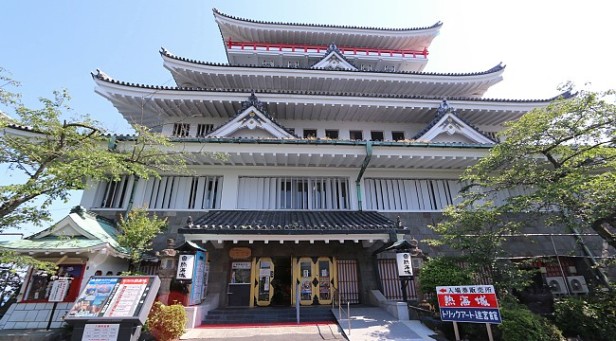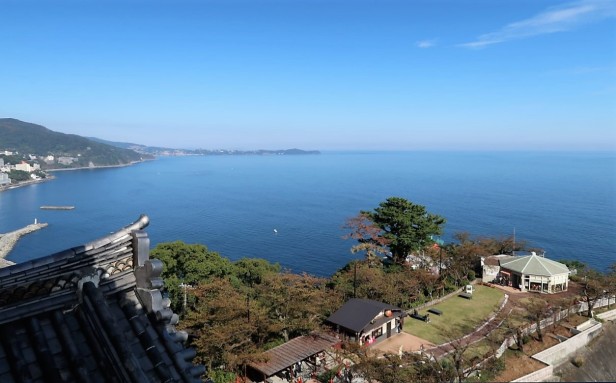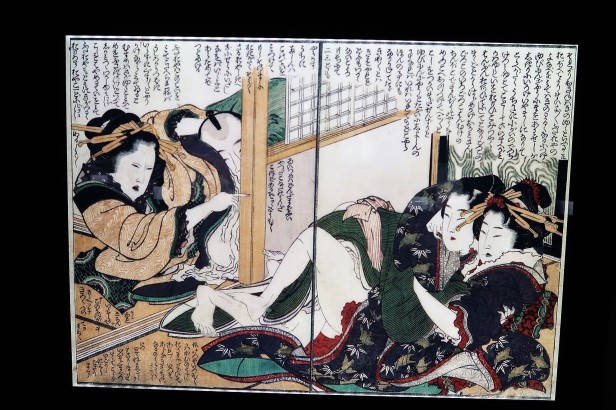
Atami, a historical leisure city
Atami is a Japanese city situated in Shisuoka Prefecture only 40min bullet train away from Tokyo. Atami is a historical leisure city, which was, from the end of the 50s to the beginning of the 70s, the most popular recreation place in Japan. Atami is still a very popular city nowadays with around 2.8 million overnight visitors annually, and around 5.8 million visitors total (FPCJ, 2014).
Its proximity with Tokyo makes it an especially attractive seaside resort for Tokyoites looking for a day trip to the sea or looking forward to enjoy the hot water sources as suggested by the high number of one-day trip visitors. Nevertheless, since the 50s, Atami varies its tourist offer by creating culture, heritage related facilities.
Atami Castle, heritage re-creation
The best example in the city is Atami’s castle which was built in 1959 as a tourist attraction. The city is using the historical image of the new-born building – castles being a famous part of Japanese culture and history – to enhance tourist experience. In fact, the city never had a castle. Thus, the fact that this castle was built just for tourism demonstrates how the town is exploiting culture to extend its touristic offer.

The castle is now used by the city as a “showcase” of Japanese culture. Allowing tourists to wear traditional Edo period clothes, and providing some various types of heritage related entertainment such as Japanese wood prints exposition or Japanese riddles. It is also the most popular viewpoint in the city and one of the festivals hot spots.

The Kiunkyaku ryokan (traditional Japanese inn), is another good example of the use of heritage for touristic purpose. It was bought by the city back in 2000 when the place was closed for business and was then turned into a tourist hotspot. Hence, this place provides the city a touristic place related to Atami’s history since the city has a long hot springs tradition.
Hence, the city is using both national and local heritage to diversify its tourist offer and provide a better experience for tourists looking for a more cultural related experience. Thus, the city is using culture, relative to the city or made-up, to attract different type of tourists and improve the experience of the tourists who, most likely, came to enjoy the onsens (hot spring resorts) and the sea.
Culture, a potential lever to attract international tourists?
Atami is aiming to attract international tourists since they only represented 1% of the city’s total visitors in 2014. They are planning to use the “fame” of Tokyo 2020 Olympics to make Atami a more well-known city for international tourists. Moreover, international tourists are more likely to be interested in Japanese culture and hence, culture related facilities. Festival and attraction development is of interest to the city of Atami in order to achieve its goal of becoming the number one onsen city in Japan.
Sources:
Foreign Press Center Japan, (2014) Mayor/Governor Interviews, City of Atami: Mr Sakae Saito, Mayor (December 2014) [Online] available at: http://fpcj.jp/en/useful-en/chief-en/p=27976/ (Accessed: 24-11-17)
Mansfield, S. (2011) Culture mingle amid Atami’s hot springs, Japan times [Online] Available at: https://www.japantimes.co.jp/life/2011/12/18/life/cultures-mingle-amid-atamis-hot-springs/#.WhqlgEqgI2y (Accessed: 24-11-17)
Guichard-Anguis, S. and Moon, O. (2009) ‘Japanese tourism and travel culture’ London, Routeledge
Visit Atami (2017) Plan your visit Available at: http://travel.ataminews.gr.jp/en/plan/ (Accessed 23-11-17)
Japan-guide (2017) Atami Castle Available at: https://www.japan-guide.com/e/e6318.html (Accessed 23-11-17)
